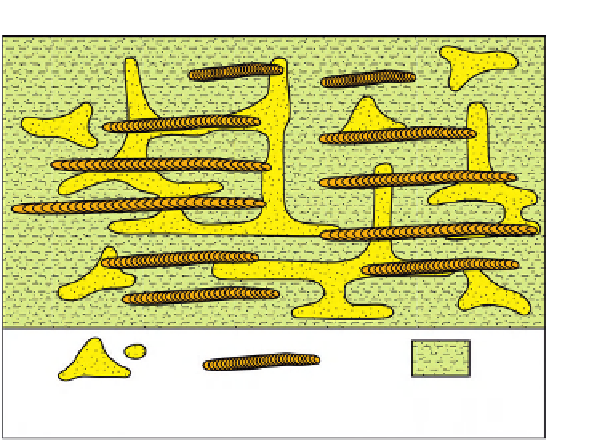Environmental Engineering Reference
In-Depth Information
Sand-filled
Thalassinoides
Zoophycos
Silty shale matrix
FIGURE 9
Foram-filled
Zoophycos
(Zo), encased in a lower permeability matrix, form an impor-
tant part of the Sirasun Field in Indonesia. The burrows are further connected by
Thalassinoides
and
Chondrites
; thus, the biogenic reservoir is largely isotropic and is a prodigious natural gas
producer.
continuous. Stratal units characterized by non-SCD can exceed several square
kilometers in area (
Pemberton and Gingras, 2005
).
4.3.2.1 Lysing Formation (Cretaceous), Norwegian Sea
Within the Late Cretaceous Lysing Formation, biogenic fabrics appear to
enhance the reservoir permeability significantly. The Lysing Formation is com-
posed of interbedded very fine- to fine-grained sandstone, siltstone, and shale
that contain a diverse trace-fossil suite. Sediment accumulation is the result of
alternating fine- and coarse-grained sedimentation within a mid- to outer-shelf
setting. The trace-fossil assemblage includes
Thalassinoides
,
Planolites
,
Scoli-
cia
,
Chondrites
,
Palaeophycus,
and
Zoophycos
(i.e., distal
Cruziana
Ichnofa-
cies). The trace fossils commonly contain coarser sediment (fine-grained
sandstone) than the shale matrix.
Spot-permeability data taken from core datasets indicate that the burrow
permeability can be up to two orders of magnitude higher than the matrix, thus
proffering a dual-permeability flow medium. Importantly, bulk assessments
of permeability based on core-plug data indicate that the harmonic mean of
matrix
versus
burrow permeabilities provides the most accurate estimate in
the Lysing example (
Fig. 10
). The harmonic relationship suggests that the
flow is largely directed across the lower permeability matrix from burrow
to burrow. This is, in fact, characteristic of NCD dominated by sparse









Search WWH ::

Custom Search